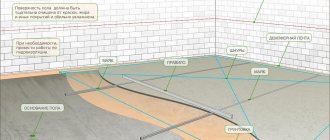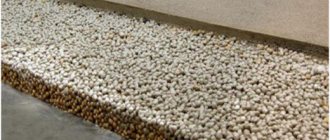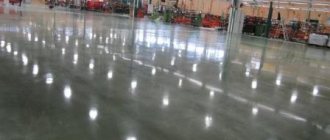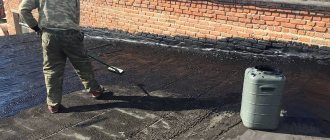An ideal concrete subfloor is what every customer wants. As Russian practice shows, in most cases the final result rarely meets expectations. The surface unpleasantly surprises with multiple faults, deformations, irregularities, “swelling”, etc. Let's look at why defects appear and how to repair cracks in the floor screed.
Causes of defects
The cement mixture has low ductility, adhesion and a fairly high coefficient of linear expansion.
Why does floor screed crack? In fact, there are plenty of reasons for flaws to appear on the rough foundation. As practice shows, cracks, dents and potholes can occur even if the grout is professionally poured. What is this connected with? It is worth noting that defects in most cases appear after installation of the cement screed. When laying semi-dry and gypsum mixtures, cracking of the coating occurs much less frequently.
Peaks and valleys in the coating inevitably appear after installation and dismantling of beacons. The reason for the formation of flaws lies in the physical and mechanical properties of the solution itself. The cement mixture has low plasticity, adhesion and a fairly high coefficient of linear expansion. Therefore, even if a little time passes between the installation and dismantling of the beacons, this inevitably leads to the appearance of small holes and cracks.
What are the main reasons for the formation of defects on the screed?
- Incorrect mixing of the solution, in which the water concentration becomes too high;
- Rapid (forced) drying of the coating;
- Uneven drying of the screed around the perimeter;
- Absence of a membrane base (polyethylene) under the solution;
- The presence of high temperature changes and drafts;
- Pouring too thin a layer of mortar;
- Direct contact of the cement mixture with the wall and communications;
- Using a fine-grained mixture that is unsuitable for pouring mortar;
- Absence or non-compliance with the required distances for expansion joints.
The reasons for the appearance of defects on the rough foundation are varied and are not limited to the list presented. The quality of the concrete pavement can also be affected by:
- Incorrect installation of thermal and waterproofing insulation;
- Poor quality cement mixture;
- Heterogeneity of the prepared solution;
- Lack of necessary tools for pouring and leveling concrete;
- Failure to comply with proportions in the process of preparing the working composition.
Conclusion
To avoid repair work after drying, you just need to follow the technology for laying the screed. Let's summarize: First of all, we observe the proportions of the mixture. Excess water 100% will give us cracks on the dry floor. Preparation of the base also plays a big role. If it absorbs moisture, the screed will need to be reinforced in any case.
And the most important thing! There is no need to speed up the drying of the solution by artificial drafts or heating the room. With such actions, moisture evaporates unevenly and quickly, which will also cause cracks.
Remember!
The screed on the floor should dry on its own, gradually and at an equal temperature. If the weather outside is hot or, on the contrary, windy, it will need to be moistened, thereby protecting it from rapid drying. To carry out this process, wet burlap is mainly used.
By following these simple rules when pouring screed, you will never have cracks on your floor.
Recommendations for floor repairs
An example of expansion joints to prevent cracking
Repairing a floor screed is a responsible undertaking that requires strict adherence to the rules for restoring old and freshly poured screeds. To repair the base without any problems, before performing the procedure you should pay attention to the following nuances:
- First you need to find out exactly the reason for the formation of flaws;
- Check whether there are expansion joints on the coating;
- Find out how the cement mixture was poured, what base the solution was laid on (concrete, wood);
- If there are no expansion joints on the floor, before repairing cracks and potholes, it is advisable to take care of laying them;
- To determine whether local delamination of concrete is present, it is advisable to tap the coating with a rubber hammer.
If you ignore all of the above recommendations, within a couple of months potholes, dents and “boiling” concrete will again appear on the base. You can learn more about how to eliminate defects on a cement screed from the video clip.
Do-it-yourself floor screed with expanded clay: methods and calculations of consumption
Main types of defects
When renovating an apartment, many craftsmen are faced with the problem of violating the integrity of the screed. Considering that when pouring a concrete mixture it is almost impossible to ensure uniform drying of the solution, the risk of defects increases significantly. How to repair the coating in this case?
Small cracks usually occur due to uneven hardening of the screed
First of all, it is worth deciding on the type of deformation. The method of eliminating defects will depend on the degree of damage to the concrete floor:
- Microcracks up to 15 mm in size. Occurs when the coating dries unevenly. If there are few cracks on the surface, you can use tile adhesive to fill them;
- A large crack measuring 2 cm or more. Such types of damage often occur due to the absence of expansion joints and mechanical stress. When renovating apartments, it is not recommended to use caustic compounds, so sealing glue or cement mortar is often used to eliminate cracks;
- "Spilling" concrete. The mobility of the concrete floor is caused by air cavities under the coating. If there is a need to seal swollen areas, the exfoliated concrete is cleaned off, and the resulting potholes are filled with cement mortar;
- Local irregularities up to 5 mm high. Bulges are simply cleaned off with a grinder, and small dents are filled with tile adhesive or mortar with M300 or M500 cement;
- Potholes and potholes larger than 15 mm. It is quite difficult to repair numerous damages locally. Therefore, in this case, experts recommend pouring a new screed with a small layer thickness - up to 4 cm.
Apartment renovation is a problem for most home craftsmen. During the process of laying concrete mixture it is very difficult to prevent drafts. But in most cases they are the ones that cause uneven drying of the base. And in order to make a high-quality restoration of the floor of an apartment, you need to use solutions and adhesives with good adhesive properties.
What to do with a cracked screed?
Often cracks do not interfere with linoleum or laminate flooring. If the plane of the floor is not disturbed, and there are no separate pieces moving underfoot, then the flooring is quite acceptable. Even slight swaying of individual pieces is not so bad under laminate, but here you need to make a decision individually, at your own peril and risk. The tiles are laid on the floor only with full confidence that there are no separate pieces that are loose, and that despite the cracks, the screed has good adhesion to the base.
This applies to regular ties; with floating ties, problems may arise in the form of individual pieces falling through and swelling. If there are many cracks and they are clearly visible on the dried surface of the floating screed, then you should think about dismantling or pouring an additional layer on top. Often, another screed on top of the cracked one is a more cost-effective solution. The most important thing is not to repeat past mistakes and not face the same result. A layer of 3 cm or more is poured on top of the cracked floating screed. The reinforcing layer must be reinforced; for such a thin layer, fiber is better suited.
The layer poured on top must necessarily be lower in brand strength - otherwise the bottom screed will “tear” even more when the top screed dries.
Whatever type of screed it is, if it is cement-based, it is recommended to water it with a small amount of water for several days after pouring. This will help the mortar to strengthen - the main strength of cement mortars is gained in the first two weeks. While cement is gaining strength, it needs moisture; it is always present in the mortar (even if the surface looks dry), but it may not be enough. Therefore, it is recommended not to neglect spilling.
The article turned out to be quite long and could have been continued, but we covered the main ideas about eliminating the causes of cracking of screeds. Fill screeds carefully!
Expansion seams
Filling expansion joints with sealant
You need to understand that repairing a floor screed must begin with eliminating the causes that caused the problem. If cracks have formed on the coating, and you assume that the reason lies in the lack of expansion joints, first of all, they need to be made.
So, to properly make expansion joints, you should:
- Make recesses in the concrete base at a distance of approximately 5 m from each other;
- Then make a groove in the resulting crack to widen the gap to 2 cm;
- After this, prime the crack and fill it with non-shrinking glue;
- Once the glue has hardened, remove the excess using sandpaper.
You can see how to make expansion joints in the video below. When renovating an apartment, experts recommend well ventilating the rooms being renovated, since non-shrinking compositions may contain harmful volatile substances.
We repair coiled areas
Heaving areas are areas of the concrete foundation that begin to move under load. To repair this type of damage:
- Remove the coating to a stable surface and check for cracks.
- Remove loose concrete, clean the slab and coat it with primer.
- Fill the resulting cracks with building mixture and let it dry.
You can also repair damaged areas using concrete injection. For this:
- About the plots.
- Using a hammer drill, drill holes in them 7-10 mm wide and up to 25 mm deep.
- Using a construction syringe filled with epoxy, fill the holes (do not fill to the brim immediately).
- Wait until the resin hardens and go over the holes again with a syringe.
- Repeat the procedure until the epoxy level stops decreasing.
- Wait a day, during which it is not recommended to walk on the surface.
After completing the repair work, it is better to strengthen the base so that the floor screed does not crack again.
Is the crack expanding?
The cement mixture itself is very susceptible to defects. In this case, it is very important to find out not only the reason for their formation, but also the dynamics of the increase in cracks in the screed. This practice especially applies to apartments in which the interfloor floors are not particularly rigid. How can you tell if there is a tendency for a crack in the foundation to grow larger?
How to make a floor screed under a laminate?
When checking the coating for the possibility of further deformation, you need to do the following:
- Stick a strip of paper over the crack;
- Do not touch the pasted area for a month;
- If the paper breaks after a specified period of time, we can talk about a tendency for the size of the crack to increase.
What to do in this case? Often, such problems arise when renovating an apartment yourself. Why? Failure to follow the rules for mixing and laying concrete mortar inevitably leads to damage to the material. To correct the situation, it is advisable to seek help from specialists. Of course, the price for restoring a subfloor can be quite high. But in this case you can be sure of the quality of the work done.
Incorrectly prepared solution
If you do not prepare the mixture for the solution yourself, but use a ready-made dry composition, you should strictly follow the instructions for use. The fact is that the manufacturer calculates exactly how much water will need to be added for the solution to acquire all its properties.
If you add too much water, the finished mixture may turn out to be too liquid and, as a result, lose its quality.
In addition, when mixing concrete, it is advisable to use mechanized equipment - a construction mixer or a drill, so that the components of the mixture are distributed evenly.
Elimination of minor defects
For repairs, small cracks are repaired using a hammer and chisel.
Doing the restoration of the screed with your own hands in the presence of small cracks is quite easy, for this you need:
- Using an angle grinder with a diamond disc, slightly widen the crevice;
- Remove loose pieces of concrete along the edge of the crack;
- Prime the resulting cracks;
- Fill the cracks with tile adhesive.
Renovating an apartment involves some difficulties that are worth mentioning. If the concrete surface is cracked in the bathroom, it is impossible to repair the defects with ordinary tile adhesive. In just a couple of months it will peel off due to high humidity in the room. If the microclimate in the room is specific, a mixture with water-repellent properties should be used to fill the defects. You can see how to repair a screed in a bathroom in the video below.
Elimination of large cracks
Repairing an old screed with large cracks in the technique differs little from the previous version. And yet, in this case, a mixture of cement and epoxy is used to fill the cracks. Large-area defects cannot be sealed with tile adhesive due to the low adhesion of the adhesive solution. What to do if the screed is cracked?
- First, the crevice needs to be grooved;
- It is desirable that the crack has a smooth edge on both sides;
- The resulting dust is removed with a vacuum cleaner so that the adhesive mixture has good adhesion to the concrete;
- After this, several deep cuts must be made across the gap to reduce the load on the seams;
- Then the prepared areas of the coating are primed;
- At the final stage of repair, a mixture based on epoxy resin is applied.
The apartment renovation with screed restoration is demonstrated in more detail in the video.
Drying rate too fast
When working with concrete, it should be remembered that its strength and durability directly depend on the time of its contact with water.
Therefore, the drying speed of the concrete screed should not be very high. Moreover, the cement floor should be covered with plastic film, and also periodically sprinkled with water so that the outer layer does not dry out prematurely, until the concrete has completely hardened.
If a mixture that dries quickly is used for the screed, it does not require such careful care, but it is still worth protecting it from direct sunlight.











